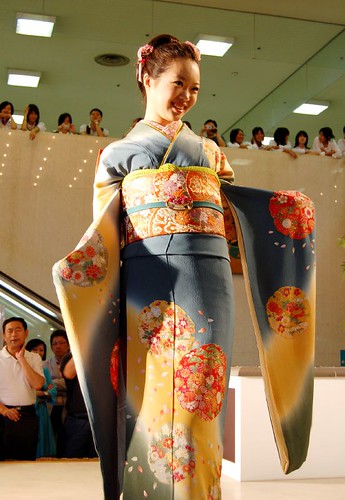 Many Japanese wore Kimonos in Ancient Japan. Kimono styles have changed with the times as with any fashion but the modern Kimono still bears a striking resemblance to those of ancient Japan. The choice of material, cut, colors, and decorative design of a kimono are different depending on many variables.
Many Japanese wore Kimonos in Ancient Japan. Kimono styles have changed with the times as with any fashion but the modern Kimono still bears a striking resemblance to those of ancient Japan. The choice of material, cut, colors, and decorative design of a kimono are different depending on many variables.
From the beginning of Japan's recorded history until present day the Kimono has been an integral part of Japanese fashion, adapting to changing lifestyles and trends. Weaving and dyeing skills and the ability of various raw materials have improved over time thus allowing the Kimono to improve in quality and design. Traditional style clothing plays and important role in Japan and even today the Imperial family will wear clothing from as far back as the Nara period during special rituals and ceremonies.
Traditional style clothing plays and important role in Japan and even today the Imperial family will wear clothing from as far back as the Nara period during special rituals and ceremonies.
Men of ancient Japan wore kimonos in white, black, brown, blue, and gray color tones which tended to be more conservative in design than those worn by females. Around the waste a narrow sash tied into a knot at the back was worn.  This was known as an Obi. In summertime, which is very hot and humid in Japan, a Yukata is worn which closely resembles a kimono except it is made of much lighter material and is usually white or blue. Floral patterns and bright colors are usually popular with women who wear kimonos. In martial arts films you may see Japanese men wearing a Hakama, or pleated pants, over their kimono. A bridegroom might decide to wear a Haori, a type of jacket, with his Hakama and kimono. Braided material tied into a fancy knot keeps the Haori closed.
This was known as an Obi. In summertime, which is very hot and humid in Japan, a Yukata is worn which closely resembles a kimono except it is made of much lighter material and is usually white or blue. Floral patterns and bright colors are usually popular with women who wear kimonos. In martial arts films you may see Japanese men wearing a Hakama, or pleated pants, over their kimono. A bridegroom might decide to wear a Haori, a type of jacket, with his Hakama and kimono. Braided material tied into a fancy knot keeps the Haori closed.
 A young woman not yet married wears a Furisode which is a bright kimono which flows around the ankles. Married women might choose to wear a similar style but with short sleeves. The Obi is often eye-catching and can be as much as 30 centimeters wide and 4 meters long taking up to an whole hour to tie properly. At a wedding a bride will usually wear a white kimono with a red or orange outer-kimono. Brighter patterns and prints have traditionally been worn by children and seldom by adults.
A young woman not yet married wears a Furisode which is a bright kimono which flows around the ankles. Married women might choose to wear a similar style but with short sleeves. The Obi is often eye-catching and can be as much as 30 centimeters wide and 4 meters long taking up to an whole hour to tie properly. At a wedding a bride will usually wear a white kimono with a red or orange outer-kimono. Brighter patterns and prints have traditionally been worn by children and seldom by adults.
 Although kimonos are not as common as they were in ancient Japan they can still often be seen on certain Japanese holidays. A special technique is used to produce these kimonos. The fabric is at least 14 meters long and up to 40 centimeters wide and is cut into eight pieces and then sewn so as to not create any waste. A lot of the material and embroidery methods originated in China.
Although kimonos are not as common as they were in ancient Japan they can still often be seen on certain Japanese holidays. A special technique is used to produce these kimonos. The fabric is at least 14 meters long and up to 40 centimeters wide and is cut into eight pieces and then sewn so as to not create any waste. A lot of the material and embroidery methods originated in China.
Japan is no longer the only country enthusiastic about kimonos as the fashion trend spreads around the world. It is easy to adapt wear them with a skirt or even pants. One can purchase Japanese fabrics and have them made into dresses, shirts, and of course kimonos.